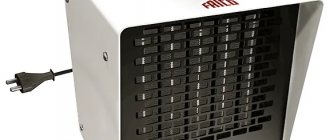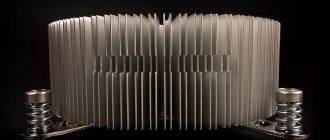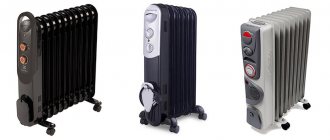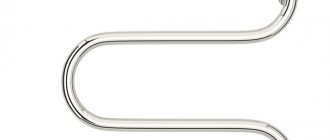The bathroom in an apartment or house is always a “wet place”. Even if you don't make puddles on the floor. Cold and hot water, steam, wet towels - everything evaporates moisture. It’s also hot in the bathroom and it creates a greenhouse effect.
Excess dampness and heat, ideally, should “go” into ventilation, but as you know, its effectiveness in city houses is far from normal. And both in the old building and in new buildings. The reason is that ventilation is natural throughout, that is, without additional exhaust.
In America, high-rise buildings have huge fans, but here the air is removed by gravity due to the difference in pressure and temperature. As a result, it moves only moderately, or even barely at all, if the houses are old and the canals are clogged.
And our “wet place”, the bathroom, is slowly acquiring all sorts of less useful flora and fauna in the form of fungus, mold and even woodlice. To get rid of such proximity or stop it in advance, you need to install an exhaust fan in the bathroom. It will draw out all the dampness where it should, and the attack in the form of unhelpful settlers will happily pass you by.
How to choose a fan for the bathroom and toilet
It seems that everything is simple, we decided that we need a fan, we go to the store and buy it. But only cats will be born quickly. A big surprise awaits you in the store from a bunch of types and models. Where there are several dozen, and where there are a couple of hundred. And you will be stuck over the question, “which fan to put in the bathroom?”
No wonder. Different types, power, models, installation methods, characteristics - the devil will break his leg in this variety of technical progress in the field of ventilation. Sellers even have a hard time sorting things out if the assortment is huge.
That's why we've put together a "guide to bathroom fans." To make your task easier and help you quickly purchase the necessary equipment. First, let's look at the general characteristics of bathroom fans.
So, let's go!
Axial, centrifugal - what does it mean?
This is a type or type of fan. He talks about the design of the equipment and its operation.
Axial fan
- This is a bladed impeller in a housing. The impeller is rotated by a motor on the rotor of which it is mounted. The blades are inclined inward relative to the plane of placement; they draw in air well and move it along a straight axis. Therefore, this type is called an axial fan. It has good performance, moderate noise, and is most often used for installation in the bathroom.
Centrifugal fan
arranged differently. The air is sucked in by a turbine with blades. Inside the housing, the flow twists into a spiral and receives additional acceleration due to centrifugal force. The flow does not exit along a straight axis, but at an angle of 90 degrees into a special device - a snail. A centrifugal fan is also called a radial fan.
It has lower productivity compared to the axial one, but can “drive the flow” under pressure of varying strengths. The noise level is low or medium, depending on the direction of bending of the rotor blades. With the front bend it makes less noise, with the rear bend it makes more noise, but it saves energy.
Overhead or channel
Ventilation equipment is available for external and internal installation. The external type of installation is mounting on a wall or ceiling at the outlet of the ventilation hole into a shaft or into a pipe system. A duct fan is a built-in equipment that is placed inside a ventilation duct (air duct). Ventilation duct systems are made of metal or plastic. For the bathroom, plastic channel systems are more often used, for example, from the Vents company.
Often the exit to the ventilation shaft is located in the toilet. For exhaust from the bathroom, an air duct with an intake grille is installed. The ventilation hose is pulled to the mine window. A duct fan with an additional grille is installed in the toilet. The hood simultaneously takes air from the entire bathroom and directs it into the ventilation shaft of the house. By design, external and duct fans are made both axial and centrifugal.
Choosing a bathroom fan by power
The power level or performance of the fan is one of the main characteristics. In fact, the hood is chosen based on it, paired with the design (axial/centrifugal). how many cubic meters of air the fan pumps per hour - 100, 200, 300.
To choose the right power, you need to calculate the volume of the bathroom and multiply it by 8. “Eight” indicates the sanitary requirement for the frequency of air changes in the room per hour. Simply put, the fan needs to pump the volume of eight of your bathrooms. Then there will be cleanliness, beauty and no mold.
How to calculate volume? It’s very simple - take the length of the room, the width, the height of the ceiling, multiply and get the desired number. We multiply it by eight and have the minimum power value.
Example!
For an urban standard bathroom with dimensions of 1.7×1.5×2.5m with an exchange rate of 8, a productivity of 51 cubic meters per hour is needed. Axial fans are produced with a power of 80 cubic meters. This hood will cope with the task even with a reserve. The centrifugal model usually “drives” from 42 to 100 cubic meters per hour.
Choosing a bathroom fan based on noise level
It is clear that the hoods make noise, but not very much. If you want something completely quiet, take the axial model from the Silent line. Their design includes mounting the engine on silent blocks, which “dampen” noise and vibration. Among the “quiet” ones, you can choose a model with a noise level of even 22 dB.
Centrifugal engines are louder because the turbine pumps air under pressure. But they also make moderate noise, about the same as a cooler in a computer. It doesn’t stop you from watching movies, listening to music or playing games. Likewise, the fan will just be in the background if you are in the bathroom when it is on.
Attention!
Noise is a secondary characteristic. The most important thing is that the hood “drives” the required volume of air for a good microclimate and fits the ventilation design.
Which fan is better for a bathroom or toilet - reviews of additional functions
Modern technology can do a lot, and fans are produced with various additional functions. Their list includes:
- Additional sensors.
They measure humidity or react to movement. - Sleep timer.
It sets the shutdown delay time, minimum 2 minutes - maximum 30. - Indicator light.
Lights up while the fan is running. - Pull cord switch.
You can turn the hood on and off at the right time. For example, when you take a shower or bath. That is, when the light in the bathroom comes on, the fan does not automatically start. - Automatic blinds.
They are used to close the ventilation grille after the duct fan is turned off. - Check valve.
Its main task is to prevent the penetration of foreign odors from the ventilation shaft.
According to reviews from our customers, most often they buy models with humidity sensors and a shutdown timer. The check valve, which blocks the flow of air from the shaft or duct back to the fan, has already become part of the structure. Very rarely it is sold separately and is considered an additional option.
Degree of moisture protection
All bathroom fans have increased moisture protection within 4-5, dust protection can be either zero or 3-4. The equipment passport will indicate IP X4, 34, 44, 45.
We've sorted out the characteristics, now let's talk about the range.
Top tips for choosing bathroom fans
- There should be no visible traces of seams, stains, or chips on the device body.
- Increased fan power means excessive consumption of electricity.
- Radial models have the lowest noise level.
- If you turn on your hood frequently, buy a surface-mounted unit.
- In a house with an extensive air exhaust line, it is better to use duct structures.
- A fan with a noise level of more than 40 dB will disturb your sleep and rest.
- The most effective devices are those with automatic humidity control.
- Axial models are designed for self-installation.
Video about tips for choosing a fan for the bathroom and toilet
Fans for bathrooms and toilets in the 220pro.ru catalog
Our store offers well-known and popular brands of household bathroom fans:
| Soler & Palau | Blauberg | Fresh | Era | Vents | MMotors JSC |
Let's divide them into groups and get to know each other better.
For a city bathroom or standard-sized bathroom, the most popular type of exhaust fan is a model with a power of up to 100 m3/hour
The catalog contains:
Surface-mounted axial fans
Soler & Palau
| SILENT-100 CZ SILVER DESIGN-3C | SILENT-100 CZ GOLD | SILENT-100 CHZ | SILENT-100 CMZ |
| ECOAIR DESIGN 100 H (with humidity sensor) | ECOAIR DESIGN 100 M (with cord) | ECOAIR DESIGN 100 S (basic model) | EDM 80L |
| SILENT-100 CZ | |||
| Power 65-95 m3, noise 26.5-33 dB, the basic Silent model has a check valve and quiet running bearings (CZ), other models can optionally be added - timer (R), humidity sensor (H), cord switch (M ). | |||
Blauberg
| Aero Still Vintage 100 | Aero Still 100 | Aero Still 100 T | Sileo 100 |
| Power 84, 97 cu.m. meters, noise level 25 dB, additional options include cord switch and timer. | |||
Era
| FAVORITE 4 | COMFORT 4 | DISC 4 | E 100 S |
| OPTIMA 4 | |||
| Power 80-90-95-97 m3, noise level 35 dB. Models with additional options have additional coding 01 - power cable and switch, 02 - traction motor, C - check valve. | |||
MMotors JSC
| MM-100 S (basic) | MM-100 S OK (with check valve) |
Power 60 cubic meters, noise 25 dB, ultra-thin models with a thickness of 4 cm.
Duct axial fans
For installation in a round air duct, duct models are used. Among low-power ones we offer Bulgarian MMotors JSC
| BO 90 | BO 90T |
Power 50 m3, noise 36 dB, operating temperature +100-150°C.
Centrifugal fans
Due to the design and the creation of additional traction, such hoods, even at low power, are more efficient than axial ones. They cost more, so they are taken less often. Although the “usefulness” of a centrifugal fan quickly pays for its cost.
The main operating mode is minimum speed and minimum energy consumption. The hood works great for a long time in the background for routine cleaning. When the humidity rises, the maximum mode is switched on and the air in the bathroom is quickly replaced.
Among the centrifugal ones we offer a fan from the company Era
| SOLO 4C era |
Three-speed, capacity 42/64/100 m3, noise level 25.8-30 dB, equipped with a check valve and filter. Suitable for wall/ceiling installation and vent mounting.
In new houses, with large apartments, townhouses and cottages, the bathrooms are more spacious and for cleaning they are equipped with hoods with a capacity of 100 to 400 m3 per hour
The 220pro.ru catalog presents the following models:
Axial fans for wall or ceiling
Blauberg
| Aero Chrome 100 | Aero Still Vintage 125 | Aero Still Vintage 150 | Aero Still 125 |
| Aero Still 150 | Deco 100 (ceiling) |
Power 102, 154, 254 m3, noise level 31-33-38 dB, all models have a check valve, additional options are indicated by letter markings, T - with a timer, ST - with a cord and a timer. Ceiling ones have a power of 105 cubic meters and a noise level of 37 dB.
Soler & Polau
| SILENT-200 CRZ (with timer) | SILENT-300 CHZ (with timer and humidity sensor) | EDM 200C | Decor 200С |
Capacity 175, 180, 280, 320 m3, noise level in the SILENT series 35-36 dB, in other models 42-47 dB.
Era
| ERA 5S | ERA 6C (with check valve) | SLIM 5 | SLIM 6-02 (with pull cord switch) |
Capacity 140-183, 250-290 m3, noise level 30-33, 36-38 dB.
FRESH
| PAX Norte (quietest model at 17 dB) | INTELLIGENT White | INTELLIGENT Black |
Capacity 110-132m3, noise 17-22dB. New generation fans. Equipped with a smart control system, speed switching mode, and sensors. They can work automatically using a built-in program or run in the selected mode via a smartphone or computer.
Duct hoods
Blauberg
| Tubo 100 | Tubo 125 | Tubo 150 | Turbo 100 |
| power 137, 245, 361 m3, noise level 38-39-40 dB. | two-speed, power 170/220 m3 per hour, noise level - 27/32 dB, wall or ceiling mounting. | ||
Soler & Palau
| TDM100 | TDM200 | TDM300 | Silentub 100 |
| power 110-200-300 cubic meters, noise 40-45 dB, suitable for short round air ducts and for installation in a ventilation hole in the wall. | power 100 cubic meters, noise 37.5 dB, for short round channels and for wall mounting. | ||
Era
| PRO 4 | PRO 5 | PRO 6 |
productivity 115, 195, 320 cubic meters per hour, noise from 32 to 36 decibels, mounted on a wall or ceiling, both exhaust and air supply work.
Vents
| iFan D100/125 |
intelligent, maximum power 106 m3, in quiet mode - 72. noise level 31 dB (22 in quiet). Basic humidity control, timer, additional speed control - motion sensor operation. Suitable for non-stop ventilation at a capacity of up to 40 m3/hour.
Exhaust fan for the bathroom - the best option
If we talk about choice and answer the question, “which bathroom exhaust fan is best?” then there will be several optimal options:
- for a regular bathroom with a separate ventilation hole;
- for general ventilation of the bathroom;
- for a large bathroom.
The bathroom has direct access to the shaft
The best option is a wall-mounted axial fan with a power of up to 100 cubic meters per hour. Take Blauberg or Soler & Palau. Most models have a non-return valve; it will protect against backflow of air from the shaft when the hood is turned off. And during operation, it will quickly clean the air and do it very quietly (background sound within 25-33 dB).
Models with classic design from Blauberg
| Aero Still Vintage 100 | Sileo 100 |
Or modern designer fans from S&P
| SILENT-100 CZ SILVER DESIGN-3C | ECOAIR DESIGN 100 S |
German hoods are quite a budget option; there are Spanish ones, both budget and expensive. Although their “expensiveness” is very relative. You take equipment that will work for ten years, or even more. So, let’s divide the price by the service life of the fan, and we get the cost of 10 lunches in a cafe, even for a hood for 6,300 rubles.
If the apartment is rented, or you just bought it in an old building and for now you plan to do without major repairs, take an inexpensive fan from Era:
| FAVORITE 4 | OPTIMA 4 |
The price is in the range of 400-500 rubles, they pull perfectly, they are of course louder than imported ones, but they will work like clockwork for 2-3 years.
General ventilation in the bathroom
If the exit to the shaft is in the toilet, an air duct and a duct fan must be installed to extract from the bathroom. The best option would be
| Tubo 100 from Blauberg | Silentub 100 from Soler&Palau | Silentub 200 from Soler&Palau |
They will quickly clean the bathroom of moisture and steam. Air intake from the bathroom and toilet will go through the ceiling grilles.
If you want to split the ventilation:
- Install a Deco 100 ceiling fan in your bathroom. Its performance is higher (105m3) than that calculated for a standard bathroom (51m3), but that’s how it should be. The hood will have to “drive” air through curved pipes, so you need a power reserve for quick air exchange.
- In pairs and for separate ventilation of the toilet, install a duct fan. The optimal model would be Vents iFan D100/125. It can operate in turbo mode with a capacity of 106 m3 and 72 cubic meters. In addition, there is a mode for constant ventilation, at a minimum power of up to 40 cubic meters per hour.
| Deco 100 | Vents iFan D100/125 |
Ventilation for a large bathroom
If the bathroom is large, choose a powerful fan. The best options would be:
Axial external
| Aero Still Vintage 125 | INTELLIGENT White | SILENT-300 CHZ |
Duct
| Tubo 100 | TDM100 | PRO 4 | iFan D100/125 |
Centrifugal
| SOLO 4C |
Take external and duct axial fans with a power reserve, this way they clean the air faster both directly into the exhaust shaft and through the hose. Centrifugal creates increased pressure and a large capacity reserve is not needed.
Climate
69 votes
+
Vote for!
—
Vote against!
Increased humidity in the bathroom has not been a secret for a long time. To ensure clean and fresh air in the room, you need to ensure good ventilation. People try to combat high humidity in a variety of ways. However, the time has passed when you need to open the doors to the room after taking a shower and remove the water from the floor. It's time to move on to drastic measures - buying a fan for the bathroom.
- Performance
The importance of bathroom ventilation
Ventilation in the bathroom is important for human health. Typical bathrooms have a small area. Therefore, when taking a bath or shower, the room quickly fills with steam. Dampness settles on the ceiling and walls of the room, causing the bathroom finish to deteriorate. Now think about whether you need a fan in the bathroom?
Splashes of water, condensation and fumes can lead to the unwanted formation of mold and mildew, which results in unpleasant odors, harmful small insects and their noxious secretions. Removing odors and moist air is essential for your comfort and reducing the risks of allergies and respiratory diseases.
As a rule, there is no window in the bathroom. And the only way to get fresh air into the bathroom are ventilation systems. When building a house, builders must plan natural ventilation channels. The effectiveness of the ventilation system depends on the direction and location of the air flow.
Often, natural ventilation systems do not cope with their task. To check whether the natural ventilation system in the bathroom is working effectively, it is enough to carry out a small, simple test. Take a piece of paper and place it on the grill. It will stick to the grille if the system is working properly - it will be held by the air flow.
If the ventilation does not work well, the leaf will not be held. However, it should be remembered that even a normally operating system demonstrates low performance, since the principle of its operation is based on the difference in temperature in the bathroom and outside. In the summer, when it is hot outside, the ventilation hardly works.
Also, ventilation ducts become clogged over time, and the entire system loses efficiency. Remember, if in your home condensation accumulates on the surface of the walls, plumbing fixtures and furniture in the bathroom, the mirrors in the bathroom fog up and there is a constant unpleasant smell in the toilet, you should install an exhaust fan in the bathroom.
Types of exhaust fans
When purchasing a fan for a bathroom, it is worth reading that such devices are structurally divided into duct and axial, radiator and roof, which is determined by the features of their application.
Axial fans
Axial bathroom exhaust fans are a wheel with cantilever blades located in a cylindrical housing. The impeller is usually mounted on the axis of the electric motor. When the wheel rotates, air is captured by the blades and moves in the axial direction. There is practically no movement of the air mass in the radial direction.
A manifold is installed at the entrance to the bathroom hood to improve the aerodynamic characteristics of the fan. Axial models show a fairly high operating efficiency compared to other devices - productivity is more than 100 cubic meters per hour, but their pressure characteristics are low. They can be installed directly into the wall.
This type of bathroom exhaust fans is quite common due to its ease of installation. Mount wall fans into the ventilation shaft openings. In principle, such installation is a violation, because air circulation may be disrupted in general ventilation. The disadvantages of wall-mounted axial fans include a higher noise level, which often reaches 30–50 dB.
Radial fans
Fans of this type consist of a blade wheel located in a spiral casing. When the wheel rotates, air enters the holes between the blades, follows to the periphery of the blade wheel in the radial direction, is compressed and thrown under the influence of centrifugal force into a special spiral casing and then enters the discharge hole.
The working hollow cylinder has blades along the side surface, which are located parallel to the axis of rotation at an equal distance. In air cooling and ventilation systems, the quietest radial bathroom fans are used, with single or double suction, with blades curved forward or backward.
The use of radial fans, the blades of which are directed backwards, allows saving 20% of energy. Another important advantage is that they can easily withstand air flow overloads.
Bathroom exhaust fans with forward-curved blades can provide similar pressure and flow characteristics as units with rear-facing blades, with a smaller impeller diameter and low rotating speed, helping to achieve good results while creating less noise and taking up less space.
Centrifugal fans
Centrifugal duct-type fans appeared quite recently (70s), but gained great popularity due to their convenient use and considerable simplicity. Duct fans for the bathroom are used when the room area is more than 15 square meters.
The devices themselves are quite powerful, but the noise level is rated as low. Silent duct-type bathroom exhaust fans are designed to be placed in the flow part of the ventilation system. They come with a rectangular or round cross-section. Typically, a duct fan is installed under the ceiling and hidden behind plasterboard panels.
It is advisable to choose semi-rigid or rigid air ducts, because their design is considered more reliable than flexible ones - this ensures a longer service life. The centrifugal fan can be mounted in the middle of the duct or in front of the air intake opening.
Although the latter option is not very convenient, since it requires the installation of an anemostat, which prevents condensate from entering the ventilation system. However, in the first situation there are also disadvantages - due to the aerodynamic resistance of the air ducts, you need to install a more powerful fan.
Roof fans
Roof hoods are installed on the roofs of residential buildings. Roof-mounted fan units consist of a fan, an electric motor, vibration-isolating pads, as well as automatic control devices, all contained in one housing. These devices use axial multi-blade or radial devices with single or double suction blades.
Choosing a bathroom hood
When choosing a fan for the bathroom, you need to remember some parameters and technical characteristics, such as air exchange and performance, noise level and safety in a moisture-saturated environment, as well as the functionality of the devices and the price-quality ratio.
Performance
To calculate the required fan performance for your bathroom, you will need the following information: the volume of the room and the air exchange rate - the number of air changes per hour. The product of these two indicators will be the fan performance.
You can calculate the fan power using the following calculations. Calculate the volume of the room by multiplying the length of the room by its width and height, and rounding up. To obtain productivity, multiply the volume of the room by a number that shows how many times the air should be changed to fresh air in one hour.
The air exchange rate always depends on the type of room and is specified in building codes. This number for a bathroom according to building codes is 6-8. Take 6 if 1 - 3 people use the bathroom in your house, if more than 3 - substitute or 8. The air exchange rate for the toilet will be 6-10.
After the calculations have been made and the performance obtained, you can choose the best fan for the bathroom according to the parameters of various manufacturers that produce exhaust fans. Practice shows that it is necessary to take a fan that has technical indicators slightly higher than the calculated parameters. Typically, the performance of bathroom fans is 95 - 100 m3 / hour.
Noise level
Each bathroom fan is driven by an electric motor, the operation of which is always accompanied by two types of noise - mechanical and aerodynamic. The first noise can penetrate into the premises, spreading through the air duct, and the second one arises as a result of vibration of structural elements - the walls of the exhaust fan protective casing and the air ducts themselves.
Noise that is more than 35 dB has an irritating effect on the human psyche. Therefore, noise control is an urgent task when choosing and installing exhaust fans for the bathroom. Thus, the noise produced by the device should not exceed 30 dB. If you are thinking about how to buy a bathroom fan to turn on the device at night, then remember that the noise level in this case should not exceed 25 dB. Noise indicators are indicated in the passport data.
The noise level can also be reduced by installing a silencer behind the fan and lining the inner surface of the air duct with sound-absorbing material. Silencers have two main designs - tubular and plate. In any case, the diameter of the air ducts should not be too small so that air “plugs” do not form due to turbulence of air flows, but it should not be excessively large, which increases the material costs of a large bathroom fan.
Security issue
Another important requirement for a bathroom hood is its protection from moisture entering the appliance. An exhaust fan is an electrical appliance, and the bathroom is always humid. Contact with unprotected parts of the device or switch (and any electrical device has them) can cause a short circuit and significant consequences for the electrical wiring - such as a fire. This should be taken into account every time the question arises of how to choose a bathroom fan.
To avoid this, look in stores for fans that are designed specifically for the bathroom. They are marked accordingly. These are ordinary hoods, which are additionally protected against water penetration. For complete safety, bathroom exhaust fans use predominantly a voltage of 24 V. If a short circuit occurs in the wiring, such a low voltage will save the bather’s life.
Hood functionality
If you still haven’t decided which fan is best for the bathroom, you should also focus on such an important point as functionality. There are two types of bathroom hoods: automatic and standard. Standard exhaust fans are ordinary axial systems with a check valve that blocks the flow of exhaust air back into the room.
Such fans work very simply: when the light is turned on, the air exhaust starts working at the same time, when turned off, the fan stops. This is convenient, but not always practical, especially when the moisture level is very high, because such a fan will not be able to remove all the humid air from the bathroom in a short period of time.
Automatic bathroom exhaust fans are naturally more advanced, but also more expensive. They are equipped with special timers to set the device for a certain operating time. Exhaust fans with a sleep timer run for approximately 25 minutes after you leave and then turn off automatically. A fan with a humidity sensor and timer will turn on when the humidity increases above a specified limit and turn off after a time period specified by you.
How to choose a fan for the bathroom if the bathroom ventilation system is connected to the kitchen ventilation system? Bathroom hoods with a check valve are also available on the market. These devices will be a real boon if the bathroom and kitchen ventilation systems are a single whole. This type of fan draws air out of the room, preventing it from entering the kitchen.
Price-quality fan
Next, pay attention to the quality of the bathroom fan, because high technical characteristics do not always guarantee long-term operation of the device. It is better to look at the offers of famous manufacturers of bathroom fans. Positive characteristics and consumer reviews will signal that your choice has fallen on a worthy device.
Confirmation of quality is the exhaust fan’s compliance with quality standards and the presence of certificates from special commissions, warranty documents and markings, which indicate the protection class (start from the lowest value - IP 34). Remember that a bulky hood will not always be of high quality.
Today, the size of bathroom fans is in most cases compact, but the devices are quite powerful. Also on the market are built-in appliances that forcefully remove moist air from the bathroom into ventilation shafts.
A good quality bathroom fan doesn't always have to be expensive. Even the most inexpensive and simple domestic device will efficiently cope with its tasks for 3-5 years. And you can always buy a more expensive device, especially if you are interested in the high functionality of the fan.
The bathroom is one of the most humidified places in an apartment or private house. Without a doubt, the answer to the question “How to choose a fan for the bathroom?” you already know. Let us make a reservation once again that compact, but at the same time powerful models of splash-proof hoods are designed for wet rooms, the design of which prevents water from entering the air duct, minimizing the risk of a short circuit. Basically, we have listed all the criteria for choosing bathroom exhaust fans. Now all that remains is to consider installing a hood in the bathroom yourself.
How to install a fan in the bathroom
To install a hood in the bathroom you will have to complete three stages of work.
Lay the cable from the switch
A three-core cable is needed, for example, VVG 3X1.5 mm2. It is best to “throw it” in the corrugation under the tiles and in the wall if the finishing of the bathroom is not yet finished. If the bathroom is finished, then we lay the corrugated cable along the main ceiling; you can additionally take a cable channel. We will hide all this “goodness” behind a suspended or suspended ceiling after installing and connecting the hood.
| VVG 3Х1.5 mm2 | PVC corrugation | Cable channel |
Secure the fan
When the cable is laid, you need to install the fan in place. The outer one is fixed on top of the wall, the duct inside the ventilation hole. Please note that the standard hole width is 10 cm, just for the insertion of fans with a size marking of 100 mm (diameter of the flange or the device itself). This clearance is designed for the passage of air with a volume of up to 100 cubic meters per hour. The power of hoods connected to the hundredth pipe “fits” into this requirement or slightly exceeds it, by 10-15 m3.
Fans with higher performance are connected to air ducts with a diameter of 125 mm or 150-160 mm, and the hole will have to be expanded. Otherwise, the hood or flange simply will not fit into the gap.
Food for thought! Is it possible to install an adapter from larger to smaller diameter for an outdoor fan? It's possible, but it's not necessary. You will get a decent gap between the hood body and the wall. The gap will prevent the fan from being properly secured. In addition, moisture will settle on the back panel, which is not pressed against the wall, and dust will collect. And by “cutting” the width of the lumen, you are also “cutting” the channel capacity. The relationship between channel diameter and fan performance was not chosen by chance. Your unfortunate hood will try to cram 150-200 cubes where only a hundred can “fit.”
Installing a fan in the bathroom - installation methods
The hood can be installed in different ways. Attach the overhead to the wall with self-tapping screws or glue it, insert the duct directly into the hole and secure it, or first install the pipe into the gap, and “fix” the fan already in it.
To install a surface-mounted hood , remove the front panel, which is secured with a screw at the end or plastic latches. To install with self-tapping screws, mark the holes on the wall with a pencil, then drill and insert the dowels. Attach the fan and tighten the screws.
For fastening with glue or liquid nails, apply it along the edge of the housing on the fan and on the wall. In order not to miss on the wall, trace the contour of the hood and coat it with glue inside the rectangle, slightly stepping back from the edge. Press and secure with masking (mounting) tape so that the glue sets.
Note! We do not recommend using regular tape because it may leave marks on the wall and the fan itself.
Lead the power cable out into a special hole before fastening it. If it is located inconveniently, you can drill your own in the right place. The front panel is put in place after connecting the power cable.
To install a ducted hood, use a piece of air duct of equal diameter, into which a fan with a protrusion is placed. The hood body “fits” tightly into the round channel and is fixed without additional fasteners.
If the body has no protrusions, then it is secured in the pipe with self-tapping screws through special grooves. For such fans, it is more convenient to first insert the hood into a piece of the air duct, secure it, remove the cable, and then install the entire assembly into the ventilation hole and secure it with foam.
For models with fasteners on the body, the insert is not needed. The fan is simply screwed to the wall of the hole.










